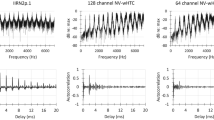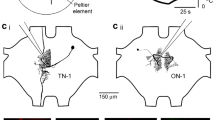Summary
Cochlear microphonic (CM) and evoked neural potentials (N1) were recorded from the cochlear aqueduct of awakePteronotus parnellii. The CM audiograms obtained with continuous sounds had more or less uniform thresholds except for a sharp threshold notch at about 60 kHz (Fig. 1). When brief tone bursts were presented, the envelopes of the CM responses were always similar to the envelopes of the applied signals except when tone bursts having frequencies at or close to the frequency of the tuned sensitivity notch were presented (i.e., 59–63 kHz). The CM rise-decay times for frequencies around 60kHz were much longer than those of the presented signals (Fig. 2). The prolonged decay times are thought to be due to the ringing of the basilar membrane resulting from a mechanical resonance in the cochlea.
The evoked neural potential audiograms (N1-on and N1-off responses) differed considerably from the CM audiogram. Of particular importance is the N1-off audiogram which exhibited very sharp tuning in four frequency regions: 31–33 kHz, 60–63 kHz, 71–73 kHz, and 91–92 kHz (Fig. 5). The frequencies evoking the lowest thresholds of the CM and N1-off (in the 60 kHz region) were either identical or differed by only 100–400 Hz.
The sharp tuning in the 60 kHz region of both the CM and N1 audiograms could be eliminated by presenting 90–100 dB continuous sounds for one min but only if the signal frequency was equal to the tuned frequency of the CM audiogram (Figs. 8–13). Presenting intense sounds having frequencies above or below the tuned 60kHz region had no effect on the audiogram. The overstimulation procedure had remarkably specific effects on the CM and N1-off audiograms causing the greatest threshold increases at the 60 kHz tuned frequency and progressively smaller threshold changes on the slopes of the tuned notch.
Assuming that the sharp changes of the N1-off thresholds reflect some important underlying mechanism, the N1-off audiograms demonstrate multiple specializations in the peripheral auditory system ofPteronotus with the bat possessing at least three and possibly four sharply tuned regions. With regard to mechanism, the tuned notch in the CM audiogram, the curious CM rise-decay times evoked by tone bursts, and the ease with which the 60 kHz sensitivity notch can be eliminated all argue strongly in favor of a mechanical resonance in the cochlea which is responsible for the sharp tuning around 60 kHz. On the other hand, the absence of tuned notches in the 30 kHz and 90 kHz regions of the CM audiogram together with the absence of any discernable ringing of the CM potentials evoked by 30 kHz and 90 kHz tone bursts both argue against a resonance mechanism for the tuning at these harmonically related frequency regions. Finally, the fact that overstimulating the 60 kHz region had no discernable effect on the N1-off tuning at 30 kHz and 90 kHz demonstrates that the mechanism responsible for the tuned regions at 30 kHz and 90 kHz are independent of the resonance feature of the cochlea at 60 kHz.
Similar content being viewed by others
Abbreviations
- BF :
-
best frequency
- CF :
-
constant frequency
- CM :
-
cochlear microphonics
- CM-aft :
-
after-response of the CM
- FM :
-
frequency modulated
- N 1 :
-
evoked neural potentials
References
Bruns, V.: Peripheral auditory tuning for fine frequency analysis by the CF-FM bat,Rhinolophus ferrumequinum. I. Mechanical specialization of the cochlea. J. Comp. Physiol.106, 77–86 (1976a)
Bruns, V.: Peripheral auditory tuning for fine frequency analysis by the CF-FM bat,Rhinolophus ferrumequinum. II. Frequency mapping in the cochlea. J. Comp. Physiol.106, 87–97 (1976b)
Grinnell, A.D.: Mechanisms of overcoming interference in echolocating animals. In: Les Systémes Sonars Animaux, Vol. I. Busnell, R.G. (ed.) pp. 451–481. Jouy-en-Josas 78, France: Lab. Physiol. Acoust., INRA-CNRZ. 1967
Grinnell, A.D.: Comparative auditory neurophysiology of neotropical bats employing different echolocation signals. Z. Vergl. Physiol.68, 117–153 (1970)
Henson, M.M.: Unusual nerve fiber distribution in the cochlea of the bat,Pteronotus p. parnellii (Gray). J. Acoust. Soc. Am.53, 1739–1740 (1973)
Henson, M.M.: The basilar membrane of the bat,Pteronotus p. parnellii. Am. J. Anat.153, 143–158 (1978)
Henson, O.W. Jr., Henson, M.M.: Middle ear muscle contraction and their relation to pulse and echo-evoked potentials in the bat.Chilonycteris parnellii. In: Animal Orientation and Navigation. Galler, S.R., et al. (eds.), pp. 355–363. Washington, D.C.: U.S. Govt. Printing Office (NASA special publication No. 262). 1972
Henson, O.W. Jr., Henson, M.M.: Structure and function of the ear in the bat,Pteronotus p. parnellii. J. Acoust. Soc. Am.59, 591 (1976)
Henson, O.W. Jr., Pollak, G.D.: A technique for chronic implantation of electrodes in the cochleae of bats. Physiol. Behav.8, 1185–1188 (1972)
Kuhl, W.C., Schodder, G.R., Schroder, F.K.: Condenser transmitters and microphones with solid dielectrics for airborne ultrasonics. Acoustica4, 519–532 (1954)
Novick, A.: Orientation in neotropical bats. II. Phyllostomatidae and Desmodontidae. J. Mammal.44, 44–56 (1963)
Novick, A., Vaisnys, R.: Echolocation of flying insects by the bat,Chilonycteris parnellii. Biol. Bull.128, 297–314 (1964)
Pollak, G.D., Henson, O.W. Jr., Novick, A.: Cochlear microphonic audiograms in the “pure tone” bat,Chilonycteris parnellii parnellii. Science176, 66–68 (1972)
Schnitzler, H.-U.: Echoortung bei der FledermausChilonycteris rubiginosa. Z. Vergl. Physiol.68, 25–38 (1970)
Schnitzler, H.-U., Suga, N., Simmons, J.A.: Peripheral auditory tuning for fine frequency analysis in the CF-FM bat,Rhinolo-phus ferrumequinum. J. Comp. Physiol.106, 99–110 (1976)
Suga, N., Simmons, J.A., Jen, P. H.-S.: Peripheral specialization in fine analysis of Doppler-shifted echoes in the auditory system of the CF-FM bat,Pteronotus parnellii. J. Exp. Biol.63, 161–192 (1975)
Suga, N., Jen, P. H.-S.: Further studies on the peripheral auditory system of CF-FM bats specialized for fine frequency analysis of Doppler-shifted echoes. J. Exp. Biol.69, 207–232 (1977)
Suga, N., O'Neill, W.E., Manabe, T.: Cortical neurons sensitive to combinations of information bearing elements of biosonar signals in the mustache bat. Science200, 778–781 (1978)
Author information
Authors and Affiliations
Additional information
We thank Professor Alvin Novick for the generous support provided during the conduct of these experiments. We also thank Professor Gerhard Neuweiler and Dr. Gerd Schuller for their helpful comments and suggestions. Supported by PHS Grant NB7616 11.
Rights and permissions
About this article
Cite this article
Pollak, G., Henson, O.W. & Johnson, R. Multiple specializations in the peripheral auditory system of the CF-FM bat,Pteronotus parnellii . J. Comp. Physiol. 131, 255–266 (1979). https://doi.org/10.1007/BF00610433
Accepted:
Issue Date:
DOI: https://doi.org/10.1007/BF00610433




